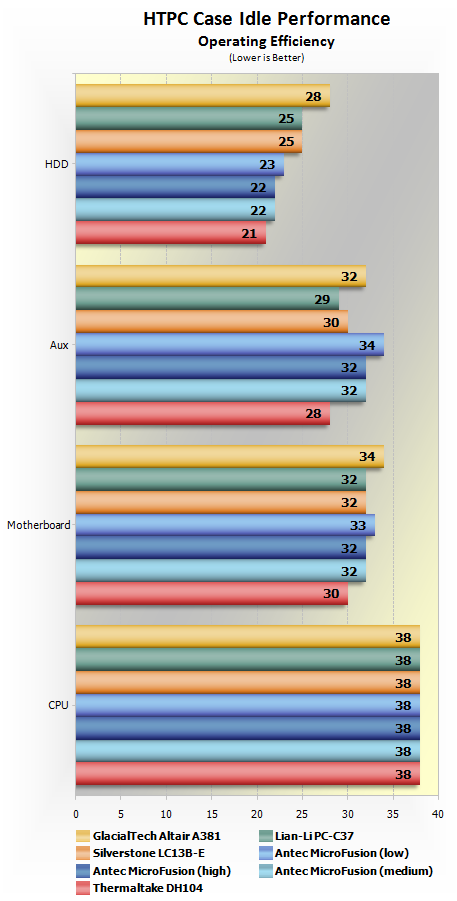Testing: Thermal Performance
Possibly the most important aspect of a HTPC case is thermal performance, so we have placed the same platform in each case to determine the cooling efficiency of each product.
The test hardware consists of a micro-ATX board (ASUS P5N73-AM) which was selected for its compatibility, which will be accompanied by a Core 2 Duo E8600 processor. In addition we will also be measuring the temperature of a 640GB Samsung hard drive.

Leaving the system at idle means that there is no CPU or HDD activity, so every component is operating at its coolest possible temperature while still powered up. As you can see, the Core 2 Duo E8600 processor operated at 38 degrees despite of which case it was installed on when at idle.
The motherboard temperatures varied up to 13%, with the Thermaltake DH104 delivering the best result. The majority of the cases allowed for a motherboard temperature of 32 degrees, which was 2 degrees warmer that the Thermaltake DH104. The GlacialTech Altair A381 was the worst performer, reaching 34 degrees.
There was also a 4 degree variation when measuring the auxiliary power temperature. Again, the Thermaltake DH104 delivered the best result, allowing the temperature to rise no higher than 28 degrees while at idle. The Lian-Li PC-C37 was also very good here, reaching 29 degrees, while the Silverstone LC13B-E maxed out at 30 degrees. The worst performers here were the Antec and GlacialTech cases.
Surprisingly, the hard drive temperatures fluctuated the most with the system in an idle state. The Thermaltake DH104 was the leader again, keeping the Samsung hard drive at just 21 degrees, which was room temperature. The Antec MicroFusion was the next best performer, keeping the drive at 22-23 degrees. The GlacialTech Altair A381 was the worst performer, allowing the drive to reach 28 degrees while inactive.

As you can see, the Thermaltake DH104 remains on top of things even when under load, keeping the Core 2 Duo E8600 processor at a cool 48 degrees.
With the Antec MicroFusion, fans wound up to full speed, and even then the case kept the processor at 51 degrees. The much quieter Silverstone and Lian-Li cases do quite well with a load temperature of 54 degrees, while the Antec and GlacialTech cases struggle reaching temperatures in excess of 56 degrees.
The motherboard temperature now varies as much as 17% under load. The Antec MicroFusion with its fans at full speed delivered the best absolute result, though under normal operating conditions we'd much prefer the fans at their lowest speed which produced the second worst result. The GlacialTech case was again the worst performer out of this bunch of top quality HTPC contenders.
The auxiliary power results favored the Thermaltake DH104, now unsurprisingly with a load temperature of 38 degrees. The Lian-Li case was really close at just 39 degrees. The Silverstone LC13B-E was able to match the Antec MicroFusion with its fans set to full speed, with both maxing out at 40 degrees. The worst results were seen when operating the Antec MicroFusion fans at a more tolerable level, and again when looking at the GlacialTech case.
Finally, we have the hard disk drive temperatures though unlike idle here those don't vary as much. The Thermaltake DH104 was able to keep the drive at just 22 degrees, the Lian-Li and Silverstone cases both reached 25 degrees, and the GlacialTech maxing out at 28 degrees.